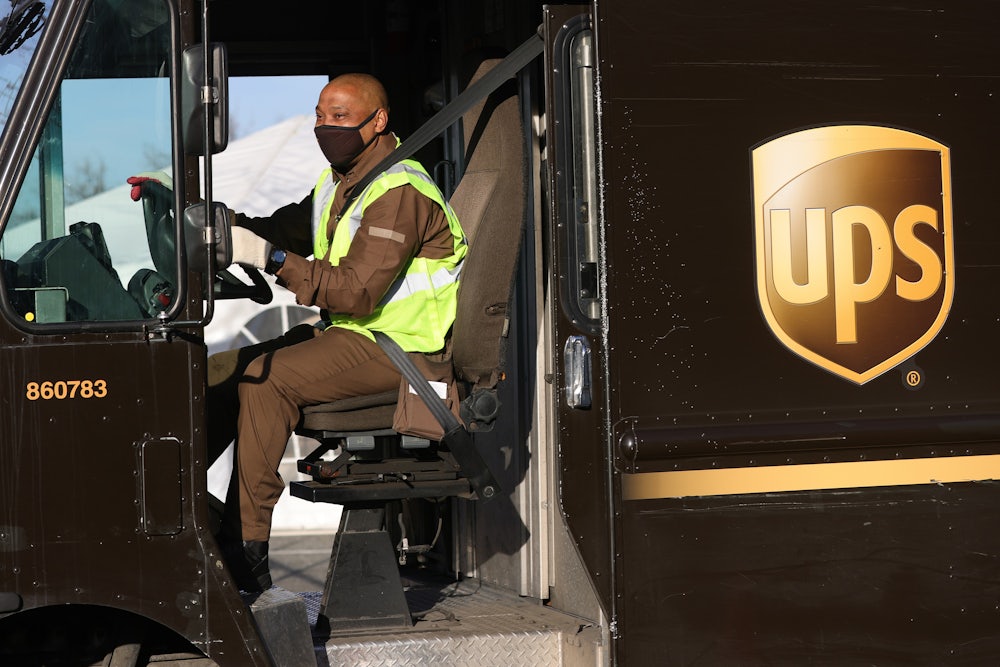The holiday season is upon us. The day after Thanksgiving, Black Friday, will yet again mark the beginning of the most wonderful time of the year: a surge in e-commerce spending, gifts galore delivered right to our doorsteps. That is, of course, if you’re not employed by United Parcel Service, better known as UPS, forced to work brutal six-day, 60-hour weeks—for two straight months—making sure Amazon-addicted Americans receive their presents on time.
“Drivers know peak season sucks. You’re gonna get that overtime, whether you like it or not,” Jared Hamil, a UPS package driver in Los Angeles, told me. 2020 was especially tough. Pandemic death, disease, and capitalism increased package volumes while taking huge numbers of people out of the workforce, crushing workers across the already pinched logistics industry.
But after the peak of 2020 ended, something strange happened. In many UPS hubs, the grind never slowed. “Once Covid-19 happened, things turned around and it was peak season all year long,” Hamil said.
UPS workers across the country have told me the same thing. When the new year turned, the six-day weeks dragged on, taking a physical and mental toll on workers, who struggled to have a life outside of work; to make dentist appointments; to see their spouses and children without the fatigue of 12-hour workdays. Without sufficient staffing, the barely tolerable seasonal crunch at UPS transformed into an intolerable chronic squeeze. “It’s been nonstop,” said Steve Dumont, a 12-year veteran of “Big Brown” in Williston, Vermont. “It’s literally been like Christmas peak season for the last three years.”
Next year, however, these workers may finally win some relief. The collective bargaining agreement, or CBA, between UPS and its workers, who are unionized with the International Brotherhood of Teamsters, is set to expire at the end of July, and forced or excessive overtime will be a central issue. The UPS national CBA is the largest private sector labor contract in the country. And with a militancy in the union not seen since the 1990s, the Teamsters leadership has warned UPS that it isn’t afraid to call a strike. With a nearly 350,000 strong workforce, it would be the largest strike against a single company in U.S. history. Transporting 6 percent of the country’s GDP, these logistics workers have incredible leverage.
The potential for change at UPS is head-spinning. But a new contract is not just a chance for UPS workers to win back their own time. The 2023 contract fight could help win it back for all of us.
Since the pandemic began, the dismal working conditions across American workplaces have come under greater scrutiny, particularly by workers themselves. “The pandemic exposed this gap,” said Barry Eidlin, an associate professor of sociology at McGill University who studies class and labor movements, “between rhetoric and reality of these workers being considered essential but then being overworked, underpaid, and disrespected.”
As labor journalists Alex Press and Jonah Furman have pointed out, it isn’t only wages, but demands over scheduling, excessive overtime, weekends, and paid time off that are increasingly the impetus for labor activity in the U.S., which has seen an uptick over the past two-and-a-half years. Indeed, it was those issues that prompted thousands of workers at Nabisco and Frito-Lay and Kellogg’s to hit the streets during “Striketober” last year. “Workers want a degree of control over their lives,” Eidlin explained, “and that’s really what mobilizes workers to take the risk of organizing or of going on strike.”
In 2023, UPS workers will demand higher pay for part-time employees, as well as the elimination of the two-tier system introduced in their last contract from 2018, under which package car drivers in the lower tier receive inferior wages and fewer benefits. But they will also fight against forced overtime, rampant harassment by supervisors, and dangerous working conditions. With forced overtime, “it’s not about the money,” Hamil said. “It’s a quality-of-life issue where we can go home and we’re not totally exhausted.”
Nowhere was that clearer than at the Teamsters for a Democratic Union’s, or TDU, 47th Annual Convention in Chicago, the home of the eight-hour day. In late October, 450 Teamsters, mostly UPS workers, united in a Rosemont hotel to chart arguably the U.S. labor movement’s most important fight in a generation. The ambiance was electric, with the president of the Association of Flight Attendants-CWA, Sara Nelson, firing up the crowd at one of the main events.
History was made as Sean O’Brien became the first Teamsters general president in 25 years to attend the event hosted by TDU, an independent grassroots organization of rank-and-file Teamsters that pushes for reforms within the union. O’Brien, who was elected in 2021 on a militant reform slate that replaced the business-friendly son of Jimmy Hoffa, vowed to “pulverize” UPS in 2023. The Bostonian Teamster leader was the first general president backed by TDU since Ron Carey, who led the national UPS strike in 1997. That strike, which TDU members played a key role in organizing, won workers huge concessions from UPS. However, the momentum was blunted by a corruption investigation into Carey’s 1996 election, which, despite his eventual vindication from the charges, ousted him from the union.
At the event’s UPS contract workshop, hundreds of Teamsters erupted in applause as O’Brien promised to once again strike against UPS if the company failed to bow to the Teamsters’ demands. “This is what I envision the union to be,” Dan Campbell, a retired Teamster and early TDU member, told me at the convention, which he said was the largest and most active since 1997. Formed by militant rank-and-file members and teamsters with ties to leftist organizations in the early 1970s, TDU has fluctuated in activity over the decades, playing a major role in Carey’s election in 1991 but fading into the background when a less militant leadership took over the union.
The effects of a successful strike could be enormous, setting better standards across the logistics industry and beyond. “The issues that the UPS workers are talking about are the key issues that are affecting workers in all parts of the economy,” said Eidlin. “There’s a potential for a demonstration effect,” he continued, shifting workers’ sense of possibility. Workers across industries might ask themselves, if the largest package courier in the world could be made to kneel, what’s stopping us from making similar demands to solve our own workplace issues, and to take action against our bosses if they’re not met?
A win could also better position the Teamsters to organize Amazon’s rapidly expanding empire, which could lower labor standards in logistics, as well as the nonunionized giant FedEx. “The UPS contract negotiations provide a living, breathing example of how you might actually go about this,” Eidlin said.
The Teamsters campaign is ramping up as workers in other contract fights refuse to concede their time and livelihoods. With the power to grind 30 percent of U.S. freight to a halt, America’s 115,000 railroad workers may strike as soon as December 4. Workers’ top concerns include a lack of sick days and draconian attendance policies that leave them unable to schedule doctor’s appointments or other nonwork priorities, lest they miss a shift and lose their job. Last month, unionized paper mill workers in Alabama rejected a contract proposal by their employer WestRock, despite $28,000 ratification bonuses. Workers were infuriated that the company removed language from the agreement that would impose penalties related to the firm’s extreme work hours and schedules.
The national importance of their fight was not lost on the UPS workers I met at the Chicago convention, and the giddiness in the air was infectious. But it was undergirded by anger and exhaustion with mistreatment in the workplace. “I have a one-year-old and my wife needs me at home to help,” said Hamil, a shop steward of Teamsters Local 396. When package volumes at his center appeared to be at their height in 2021, Hamil recalled, “Essentially, [my wife] was like a single mom, because I’m just out there, forced. There’s nothing I could do about it.”
“It’s been tough on my body in particular,” Dumont, also shop steward of Local 597, told me. After getting home at midnight from a 10 plus–hour shift and eating dinner and showering, “it’s 2 or 1:30 a.m. when I’m finally getting to bed.” He then wakes up at 6:00 a.m.
Dumont considers himself lucky, having suffered only one injury in his 12 years on the job. Others aren’t so fortunate. Several UPS workers told me that injuries and accidents have increased at their hubs since package volumes soared in 2020. “There isn’t probably a week that goes by that we don’t have an accident or injury in our center, and [management] refuses to accept that it’s because of the excessive overtime,” said Isaac Gobble, a package car driver and shop steward of Local 413 in Columbus, Ohio.
Workers also suffer a mental toll. Gobble said that he regularly has to calm his co-workers down after management disciplines them for missing a forced sixth-day shift. Walter Gustafson, a UPS warehouse worker at the same Vermont hub as Dumont, noted that it’s gotten worse since Covid. “I see just significantly more emotional outbursts,” he said. “Oftentimes you’ll be loading trucks and the quantity of packages that you’re asked to put on that truck in the time that you have is just unattainable.”
In an email response, UPS’s Director of Media Relations Matthew O’Connor wrote, “Safety is our top priority at UPS,” emphasizing that the company spends over $260 million a year on safety training in the U.S. “We provide multiple ways for our employees to share their concerns with us, and we offer world-class health care coverage that includes mental health resources that begin on their first day of employment,” he continued.
Despite the health coverage, at Gustafson and Dumont’s center, many workers are just calling it quits, exacerbating the worker shortage. “In the last couple of years, if you take any six-month window, I have seen more people quit and just leave UPS than I had in the first 10 years that I’ve been there,” said Dumont. “Guys are tired of working 11, 12, 13, 14 hours most days.”
Clauses in the current UPS contract are theoretically supposed to protect workers from excessive overtime, but many decry the language as too weak. For example, the agreement gives workers the option to sign onto the “9.5 list,” which allows individuals to file grievances if UPS makes them work over 9.5 hours more than twice a week. The penalty for UPS is that they must pay the workers grievance money. But having made nearly $13 billion in profits last year, the company is more than willing to do so. Especially because hiring more workers, with all their benefits costs, is more expensive than paying off grievances.
“Instead of trying to fix the problem, they just pay you,” said Gobble. “They’re not respecting the 9.5 list at all. Our last grievance hearing, we paid out $36,000 [9.5 grievances], and that’s just for a month.”
“Sixth-day punch” is another contract issue the UPS workers hope to fix in 2023. In many facilities, UPS can force workers to come in on Saturdays if certain conditions permit, such as higher than normal package volumes during peak season. But after Covid, when e-commerce exploded, workers say UPS exploited the sixth-day punch, and it became a constant. “They took this language and they used it to the fullest extent that will benefit them, which is having a driver that they can do whatever they want with,” Hamil fumed.
In response to questions about 9.5 violations, O’Connor, the UPS spokesperson, wrote, “Our drivers can request to work no more than 9.5 hours a day, and we continue to make improvements in the area of planned hours compared to actual hours worked.” UPS did not respond to questions about sixth-day punch.
Some workers want the overtime pay, Hamil explained. A number of UPS workers told me that the problem is they just don’t have a choice, and they risk discipline if they refuse. Brenan Burleson, a co-worker of Gobble, simply wants more time with his son, who will be four-years-old in December. “He’s at that prime age where you don’t want to miss that time,” he said. “I don’t need to work 55 hours a week to financially support myself. A normal 40-hour work week would be appreciated.”
Some powerful Teamsters locals such as 804 in New York City and 705 in Chicago secured protections from “sixth-day punch” in their regional supplements, though they still deal with 9.5 violations. Other locals aren’t so lucky, but their rank and file have taken it upon themselves to fight back.
Last year, Gobble and his union siblings at Local 413 resisted forced overtime—by complying. When management began to ramp up discipline against workers who refused to work Saturdays, all the package car drivers in the facility decided one weekend to come in at once. Normally only a fraction of a center’s drivers are called in for a sixth-day punch, but that morning supervisors were flustered to find all their drivers demanding their eight hours in solidarity. As a result, the weekend’s typically grueling load for a half dozen workers was dispersed. “It was just to send a signal [to management] that you don’t really need us, you’re just trying to intimidate everyone into coming in,” Gobble recalled.
When I asked UPSers at the TDU event whether we could expect more actions like the one in Columbus, or Local 251’s successful resistance of 70-hour weeks in 2018, I didn’t get many straight answers. But I heard consistent promises that they would bring the militant energy at the convention back to their home locals. Battling a behemoth of the logistics industry, the Teamsters will certainly need it to win next year. “I’ve never seen such willingness, from the rank and file to the top [of the Teamsters union], to take on UPS and win a great contract” said Hamil, who’s been at UPS since the 2011 peak season.
“We’re the biggest, baddest union in the
United States,” he added. “We need to show our muscles. We just haven’t used
them in a while.”
This story has been updated.


